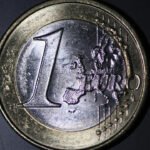EUR/USD trades in a narrow range but manages to hold above 1.1600 in the European session on Friday. In the second half of the day, September Consumer Price Index (CPI) data from the US could trigger the next big reaction in the pair.
Euro Price This week
The table below shows the percentage change of Euro (EUR) against listed major currencies this week. Euro was the weakest against the New Zealand Dollar.
| USD | EUR | GBP | JPY | CAD | AUD | NZD | CHF | |
|---|---|---|---|---|---|---|---|---|
| USD | 0.43% | 0.90% | 1.53% | -0.05% | -0.16% | -0.23% | 0.46% | |
| EUR | -0.43% | 0.47% | 1.17% | -0.48% | -0.49% | -0.72% | 0.04% | |
| GBP | -0.90% | -0.47% | 0.45% | -0.95% | -0.96% | -1.19% | -0.45% | |
| JPY | -1.53% | -1.17% | -0.45% | -1.60% | -1.69% | -1.80% | -1.14% | |
| CAD | 0.05% | 0.48% | 0.95% | 1.60% | -0.06% | -0.24% | 0.51% | |
| AUD | 0.16% | 0.49% | 0.96% | 1.69% | 0.06% | -0.23% | 0.52% | |
| NZD | 0.23% | 0.72% | 1.19% | 1.80% | 0.24% | 0.23% | 0.75% | |
| CHF | -0.46% | -0.04% | 0.45% | 1.14% | -0.51% | -0.52% | -0.75% |
The heat map shows percentage changes of major currencies against each other. The base currency is picked from the left column, while the quote currency is picked from the top row. For example, if you pick the Euro from the left column and move along the horizontal line to the US Dollar, the percentage change displayed in the box will represent EUR (base)/USD (quote).
The data from Germany showed on Friday that the business activity in the private sector expanded at an accelerating pace in October, with the preliminary HCOB Composite PMI improving to 53.8 from 52 in September.
Assessing the survey’s findings, Dr. Cyrus de la Rubia, Chief Economist at Hamburg Commercial Bank, said that the PMI report points to good conditions for growth in the fourth quarter. “However, the fact that the outlook for the future is more cautious than in the previous month, both among service providers and in industry, shows that the economic situation remains fragile,” he added.
Similarly, the HCOB Composite PMI for the Eurozone rose to 52.2 from 51.2, coming in better than the market expectation of 51. Upbeat PMI data seem to be helping the Euro stay resilient against its peers in the European session.
Annual inflation in the US, as measured by the change in the CPI, is forecast to rise to 3.1% in September from 2.9% in August. On a monthly basis, the core CPI is expected to increase by 0.3%. A stronger-than-anticipated rise in the monthly core inflation figures could support the US Dollar (USD) heading into the weekend and make it difficult for EUR/USD to gather recovery momentum. Conversely, a soft print could hurt the USD and allow EUR/USD to stretch higher in the American session.
Technical Analysis:
In the 4-hour chart, EUR/USD is currently trading at around 1.1622, little changed on a daily basis, and above the day opening price by 5 pips. A bearish 20 SMA slides below the longer ones, in line with the dominant bearish momentum and hinting at additional slides ahead. The 20 SMA stands at 1.1608. Furthermore, the 100 SMA is also bearish, falling above the shorter one, while the 200 SMA continues to edge lower around 1.1697. The 50 SMA has turned marginally higher to 1.1632 but remains capped by the 100 SMA at 1.1641. Immediate resistance is layered at 1.1632/1.1641/1.1697, while initial support emerges at the 20 SMA at 1.1608. A downwards trend line drawn from 1.1872 to 1.161 currently stands near 1.162, acting as resistance and keeping the pair contained for now.
RSI (14) has recovered to 51.3 from 46.7, just above the neutral 50 line, suggesting buyers are attempting to seize near-term control although momentum remains subdued. The Fibonacci 61.8% retracement of the rally from 1.1403 to 1.1878 aligns as a key support level at 1.1584 ahead of the static level at 1.1550.
(This content was partially created with the help of an AI tool)
Euro FAQs
The Euro is the currency for the 19 European Union countries that belong to the Eurozone. It is the second most heavily traded currency in the world behind the US Dollar. In 2022, it accounted for 31% of all foreign exchange transactions, with an average daily turnover of over $2.2 trillion a day.
EUR/USD is the most heavily traded currency pair in the world, accounting for an estimated 30% off all transactions, followed by EUR/JPY (4%), EUR/GBP (3%) and EUR/AUD (2%).
The European Central Bank (ECB) in Frankfurt, Germany, is the reserve bank for the Eurozone. The ECB sets interest rates and manages monetary policy.
The ECB’s primary mandate is to maintain price stability, which means either controlling inflation or stimulating growth. Its primary tool is the raising or lowering of interest rates. Relatively high interest rates – or the expectation of higher rates – will usually benefit the Euro and vice versa.
The ECB Governing Council makes monetary policy decisions at meetings held eight times a year. Decisions are made by heads of the Eurozone national banks and six permanent members, including the President of the ECB, Christine Lagarde.
Eurozone inflation data, measured by the Harmonized Index of Consumer Prices (HICP), is an important econometric for the Euro. If inflation rises more than expected, especially if above the ECB’s 2% target, it obliges the ECB to raise interest rates to bring it back under control.
Relatively high interest rates compared to its counterparts will usually benefit the Euro, as it makes the region more attractive as a place for global investors to park their money.
Data releases gauge the health of the economy and can impact on the Euro. Indicators such as GDP, Manufacturing and Services PMIs, employment, and consumer sentiment surveys can all influence the direction of the single currency.
A strong economy is good for the Euro. Not only does it attract more foreign investment but it may encourage the ECB to put up interest rates, which will directly strengthen the Euro. Otherwise, if economic data is weak, the Euro is likely to fall.
Economic data for the four largest economies in the euro area (Germany, France, Italy and Spain) are especially significant, as they account for 75% of the Eurozone’s economy.
Another significant data release for the Euro is the Trade Balance. This indicator measures the difference between what a country earns from its exports and what it spends on imports over a given period.
If a country produces highly sought after exports then its currency will gain in value purely from the extra demand created from foreign buyers seeking to purchase these goods. Therefore, a positive net Trade Balance strengthens a currency and vice versa for a negative balance.



















